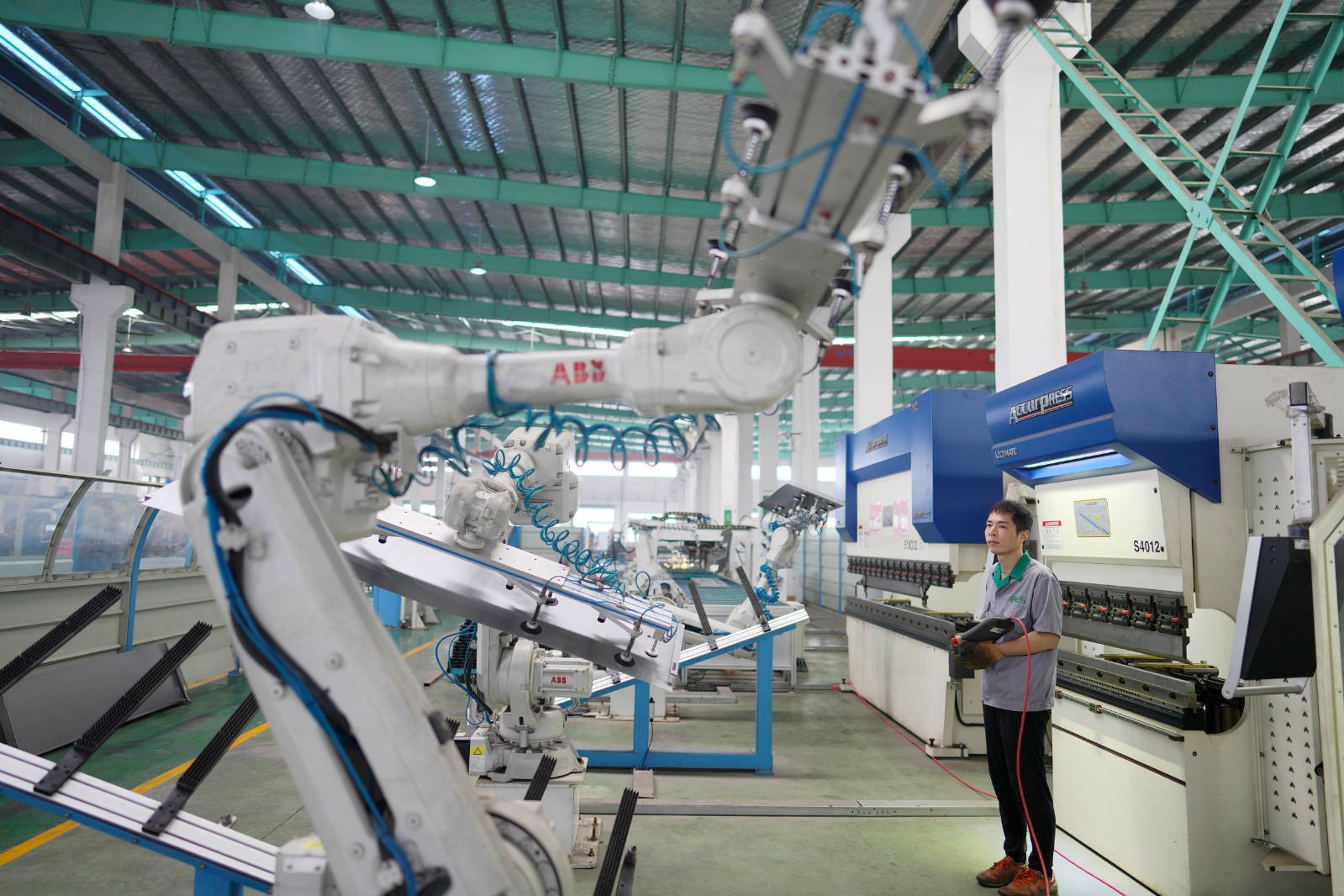

 |
| A worker controls a robotic arm at Gerson Elevator, Nanxun district, Huzhou, east China’s Zhejiang province, June 28. An elevator door, which requires 27 procedures, is now assembled by the company with only one employee, and the assembly time is 10 times faster than before. People’s Daily Online/Zhang Bin |
Unmanned traveling cranes unloading steel coils at midnight – which is a normal scene at a hot galvanizing workshop of a cold rolling mill of Baoshan Iron & Steel Co., Ltd (Baosteel), Shanghai.
The digitalized workshop, which needs no manual attendance, is able to operate automatically in the off hours, enabling the gigantic factory to function non-stop all day.
“The upgraded smart workshop can improve 30 percent of labor efficiency and 20 percent of capacity,” said an employee of the cold rolling mill. Smart manufacturing has become a sharp weapon for enterprises to improve quality and efficiency, contributing to their stable operation during the COVID-19 epidemic.
The unmanned workshop is just a miniature of the accelerated digitalization of the Chinese manufacturing sector.
According to a white paper on the development of China’s digital economy issued by China Academy of Information and Communications Technology (CAICT) on July 3, China’s digital economy embraced development with greater depth and breadth last year, and witnessed further enhancement of digital technology’s role in promoting the growth and efficiency of traditional industries. A total of 28.8 trillion yuan ($4.12 trillion) of added value was generated by industries through applying digital technologies, a nominal increase of 16.8% year-on-year.
Behind the 28.8-trillion-yuan performance is the in-depth integration of traditional industries and new technologies.
In Lvliang, north China’s Shanxi province, the last 5G base station of Pangpangta Coal Mine was installed after three months of efforts made by the employees of China Unicom, one of the largest telecommunication carriers in China. At present, over 100 kilometers of the shafts at the coal mine are covered with 5G network.
The network largely improves the safety and efficiency of mining activities. “Thanks to the 5G network, we are now able to record videos in the shafts, manage our equipment and conduct smart analysis of the work. Smart mining is no longer a dream,” said an employee of the Huozhou Coal and Electricity Group that runs the coal mine.
The new generation of information technology, including 5G and artificial intelligence, is not benefitting only the mining industry, but also the digitalization of many industrial sectors.
As of the end of 2019, 47.1 percent and 49.5 percent of the production equipment and key manufacturing procedures of Chinese enterprises above designated size had been digitalized, and 41 percent of these enterprises' digital devices had been connected to the internet. Besides, digital R&D and design tools accounted for 69.3 percent of the total in industrial enterprises. Such performance offered strong support for the in-depth digital transformation of the manufacturing sector.
Behind the 28.8-trillion-yuan performance is the released potential for digital transformation of small and medium sized enterprises (SMEs).
For instance, digital upgrading has brought unexpected changes to Qingdao Huanqiu Garments Corporation Limited based in east China's Shandong province. “By cooperating with the COSMOPlat (the world’s largest mass customization solution platform to support global industry upgrades) of Haier, we established customized service platform. It enabled us to receive customized orders from across the world,” said Yang Zhiqiang, general manager of the garment corporation.
The COSMOPlat mirrors the efforts of China’s industrial internet platforms to help with the digital transition of Chinese SMEs. Statistics indicate that the added value of China’s industrial internet hit 2.13 trillion yuan last year, surging 47.3 percent from a year ago. The integration of industrial internet into different sectors drove an economy of 1.6 trillion yuan, gradually revealing its acceleration for economic development.
Behind the 28.8-trillion-yuan performance are the emerging new business models and vitality for entrepreneurship.
QuadTalent, a digital transformation solution provider recently launched a livestream marketing event for Chinese shoemaker Topscore, innovatively broadcasted how shoes were made on the production line. Customers’ orders, once placed, were directly manufactured, and the manufacturing process was completely visible.
“The invisible barriers between the manufacturer and the clients were thus torn down,” said Min Wanli, CEO of QuadTalent.
The accelerated integration of the new generation of information technology and the manufacturing sector is constantly promoting new products, models and businesses. According to statistics, 35.3 percent, 25.3 percent and 8.1 percent of the Chinese enterprises launched internet-based collaborative manufacturing, service manufacturing and customization, respectively.
“The manufacturing sector, supported by the digital technology on the whole chain, is rising as a new ground for China’s digital economy,” said Sun Ke, director of the digital economy research department of the Policy and Economics Research Institute, CAICT.
 |

 Award-winning photos show poverty reduction achievements in NE China's Jilin province
Award-winning photos show poverty reduction achievements in NE China's Jilin province People dance to greet advent of New Year in Ameiqituo Town, Guizhou
People dance to greet advent of New Year in Ameiqituo Town, Guizhou Fire brigade in Shanghai holds group wedding
Fire brigade in Shanghai holds group wedding Tourists enjoy ice sculptures in Datan Town, north China
Tourists enjoy ice sculptures in Datan Town, north China Sunset scenery of Dayan Pagoda in Xi'an
Sunset scenery of Dayan Pagoda in Xi'an Tourists have fun at scenic spot in Nanlong Town, NW China
Tourists have fun at scenic spot in Nanlong Town, NW China Harbin attracts tourists by making best use of ice in winter
Harbin attracts tourists by making best use of ice in winter In pics: FIS Alpine Ski Women's World Cup Slalom
In pics: FIS Alpine Ski Women's World Cup Slalom Black-necked cranes rest at reservoir in Lhunzhub County, Lhasa
Black-necked cranes rest at reservoir in Lhunzhub County, Lhasa China's FAST telescope will be available to foreign scientists in April
China's FAST telescope will be available to foreign scientists in April